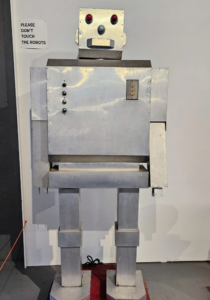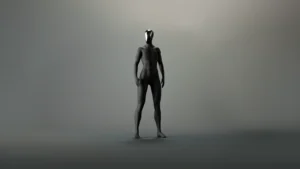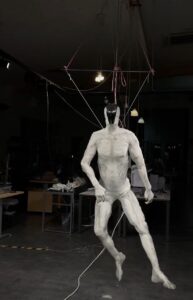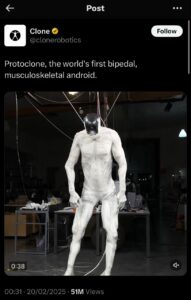From Mechanical to Human-Like
Robots have come a long way. They started as bulky, mechanical machines built to handle simple tasks.
Earlier models were useful, but they had limited movements and could only perform certain functions.

Today, humanoid robots are more advanced. They have moving fingers and toes, allowing them to do delicate tasks like sewing and writing.

But the latest step isn’t just about movement, it’s about making them look more human, too. Some now have skin-like materials and features that closely resemble actual people.

Introducing Protoclone: A Step Toward Synthetic Humans
According to Clone Robotics, their new android, Protoclone, takes a big step in mimicking human movement.
Instead of using stiff mechanical parts, it moves with artificial tendons, joints, and muscle fibers similar to real human muscles.

A video shared by Clone Robotics on X shows Protoclone, a 6-foot-tall faceless android, hanging from a support structure while moving its limbs. Some found it fascinating, while others thought it looked unsettling.
The company calls it “the world’s first bipedal, musculoskeletal android.“ However, it still can’t walk on its own.
What sets it apart is:
- Its ability to move with over 200 degrees of flexibility,
- powered by more than 1,000 artificial muscle fibers and
- has 500 sensors.
These features help it react to its surroundings more naturally.
Social Media Reactions: Awe and Fear
Social media reactions to Protoclone have been mixed. People had different opinions about Protoclone. Some were amazed by how advanced it is, while others found its human-like movements strange and creepy.
Some liked that it didn’t have a face, while others joked about needing safety measures just in case they became too advanced.

One described the marketing approach as the most unsettling and discomforting they have ever seen.

Despite concerns, some acknowledged its impressive capabilities while remaining cautious about its future role.

New Zealand-based nanotechnologist Michelle Dickinson shared her thoughts on the viral clip, calling it “both amazing and pretty petrifying,” as reported by the Daily Mail.
She noted that people might find Protoclone “weird” or “creepy” because they’re more familiar with robots that have friendly, human-like facial features.
The Future of Synthetic Humanoids
Robots are being built for more than just factories and labs—they’re now being designed for everyday tasks, from household chores to complex work in different industries.
As synthetic humanoids improve, there’s still uncertainty about their role. Will they make life easier, or will they replace even more human jobs?
Either way, they may soon become a common presence in homes and workplaces.
Watch the video here

More from Wake Up Singapore:-
Battle of the Robots: Tesla’s ‘Optimus’ vs Agibot’s ‘Yuanzheng A2’
If you have a story or a tip-off, email admin@wakeup.sg or get in touch via Whatsapp at 8882 5913.
Since you have made it to the end of the article, follow Wake Up Singapore on Telegram!
Wake Up Singapore is a volunteer-run site that covers alternative views in Singapore. If you want to volunteer with us, sign up here!
If you can, please do consider buying a mug or two to support Wake Up Singapore’s work!







